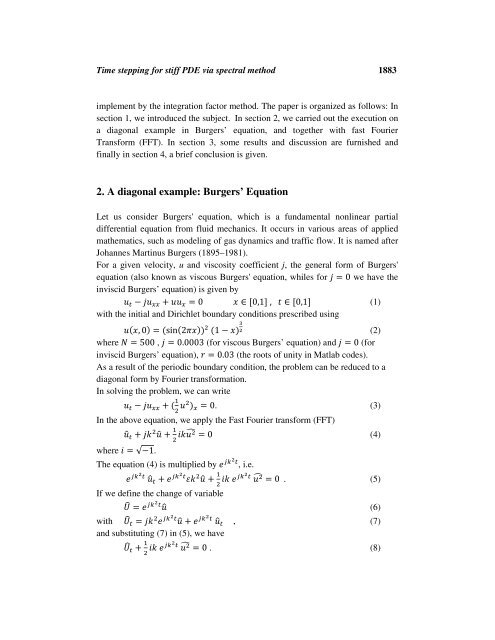A Note on Fourth-Order Time Stepping for Stiff PDE via ... - HIKARI Ltd
A Note on Fourth-Order Time Stepping for Stiff PDE via ... - HIKARI Ltd
A Note on Fourth-Order Time Stepping for Stiff PDE via ... - HIKARI Ltd
Create successful ePaper yourself
Turn your PDF publications into a flip-book with our unique Google optimized e-Paper software.
<strong>Time</strong> stepping <strong>for</strong> stiff <strong>PDE</strong> <strong>via</strong> spectral method 1883<br />
implement by the integrati<strong>on</strong> factor method. The paper is organized as follows: In<br />
secti<strong>on</strong> 1, we introduced the subject. In secti<strong>on</strong> 2, we carried out the executi<strong>on</strong> <strong>on</strong><br />
a diag<strong>on</strong>al example in Burgers’ equati<strong>on</strong>, and together with fast Fourier<br />
Trans<strong>for</strong>m (FFT). In secti<strong>on</strong> 3, some results and discussi<strong>on</strong> are furnished and<br />
finally in secti<strong>on</strong> 4, a brief c<strong>on</strong>clusi<strong>on</strong> is given.<br />
2. A diag<strong>on</strong>al example: Burgers’ Equati<strong>on</strong><br />
Let us c<strong>on</strong>sider Burgers' equati<strong>on</strong>, which is a fundamental n<strong>on</strong>linear partial<br />
differential equati<strong>on</strong> from fluid mechanics. It occurs in various areas of applied<br />
mathematics, such as modeling of gas dynamics and traffic flow. It is named after<br />
Johannes Martinus Burgers (1895–1981).<br />
For a given velocity, u and viscosity coefficient j, the general <strong>for</strong>m of Burgers'<br />
equati<strong>on</strong> (also known as viscous Burgers' equati<strong>on</strong>, whiles <strong>for</strong> 0 we have the<br />
inviscid Burgers’ equati<strong>on</strong>) is given by<br />
0 ∈ 0,1 , ∈ 0,1 (1)<br />
with the initial and Dirichlet boundary c<strong>on</strong>diti<strong>on</strong>s prescribed using<br />
, 0 sin2 1 (2)<br />
where 500 , 0.0003 (<strong>for</strong> viscous Burgers’ equati<strong>on</strong>) and 0 (<strong>for</strong><br />
inviscid Burgers’ equati<strong>on</strong>), 0.03 (the roots of unity in Matlab codes).<br />
As a result of the periodic boundary c<strong>on</strong>diti<strong>on</strong>, the problem can be reduced to a<br />
diag<strong>on</strong>al <strong>for</strong>m by Fourier trans<strong>for</strong>mati<strong>on</strong>.<br />
In solving the problem, we can write<br />
0. (3)<br />
In the above equati<strong>on</strong>, we apply the Fast Fourier trans<strong>for</strong>m (FFT)<br />
0 (4)<br />
where √1.<br />
The equati<strong>on</strong> (4) is multiplied by , i.e.<br />
<br />
<br />
<br />
0 . (5)<br />
If we define the change of variable<br />
(6)<br />
with <br />
, (7)<br />
and substituting (7) in (5), we have<br />
<br />
<br />
0 . (8)
















